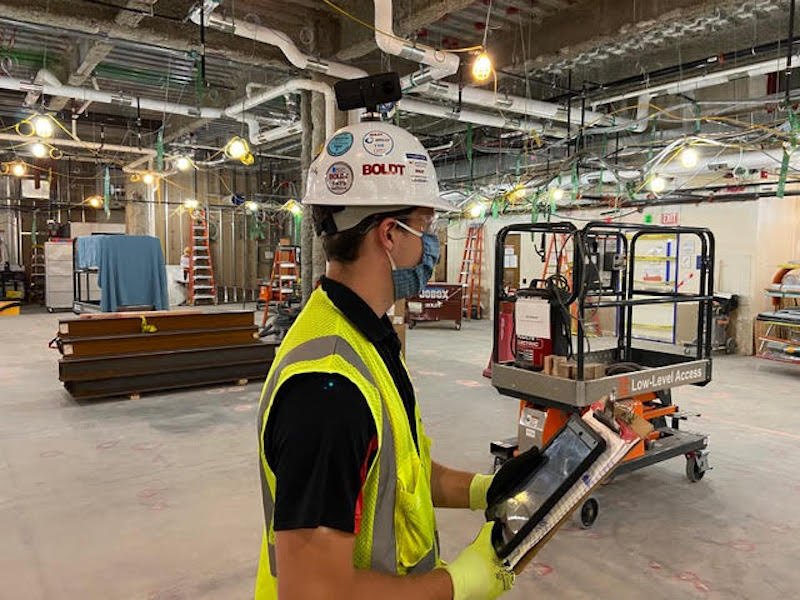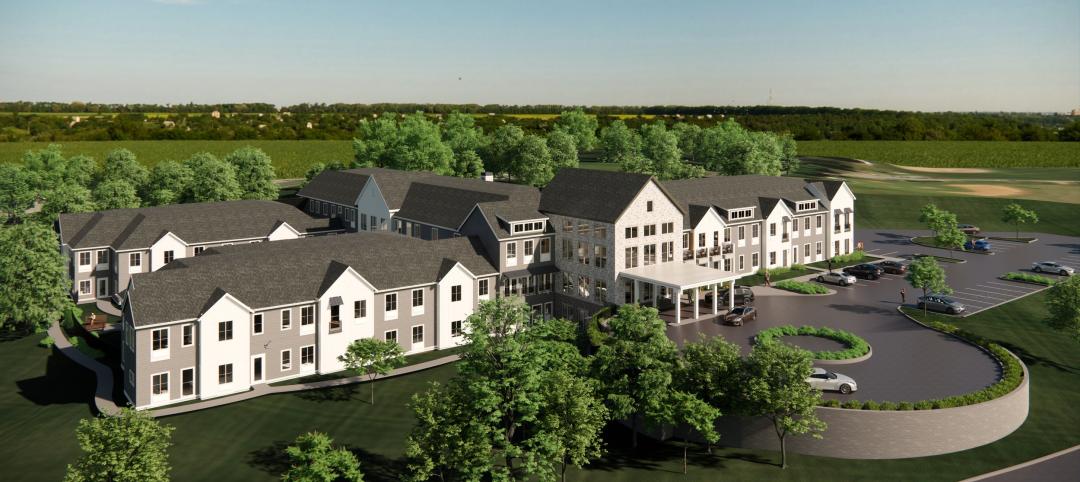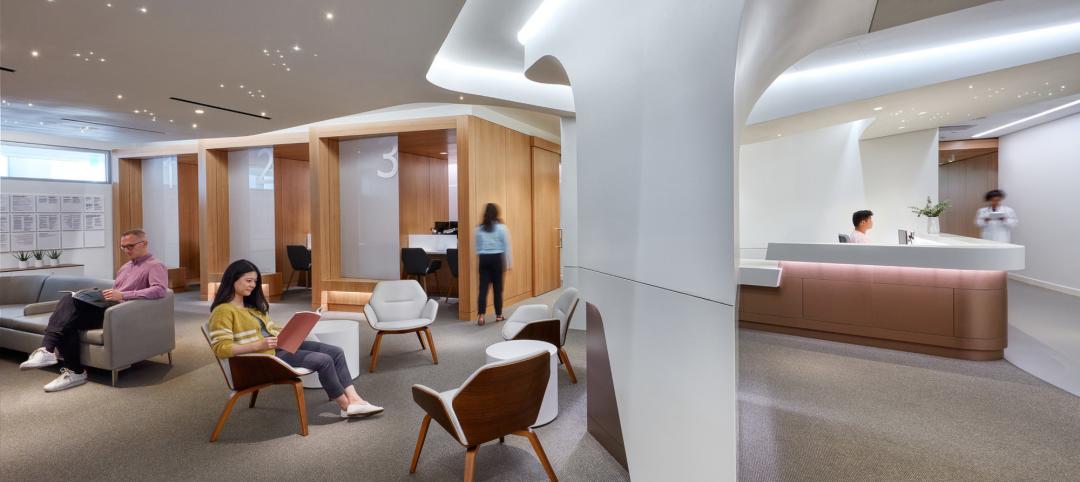APPLETON, Wis. - June 22, 2020 – When physical distancing put a wrench in the personalized give and take of building complicated structures, The Boldt Compoany relied on innovation and a creative use of technology to reopen its 14 national offices and dozens of jobsites.
The company created a task force to address facilities and technology, then tapped experts in its own technical services division to pull together a center of excellence to address reopening. “We quickly accessed the best thinking in the industry to address all the issues surrounding reopening,” said Will Lichtig, Boldt’s Executive Vice President, Performance & Innovation.
The task force identified issues for operations, safety, technology, different geographic markets, and assigned a leader for each topic. Team members identified issues such as split work schedules, team members who would continue to work from home, varying state requirements, and even the mood of their teams. “We developed a set of guiding principles within our reopening framework to provide direction for our operating groups to figure out how they want to function,” Lichtig said.
TECHNOLOGY LEADS THE WAY ON REOPENING JOBSITES AND COMPANY OFFICES
Technology quickly led the way to address safety issues and physical distancing guidelines.
“The pandemic has been a catalyst for forcing change via technology,” said Dave Much, Boldt’s Director of Emerging Technologies. “Because we’re using Microsoft Teams, it was seamless for most of our workforce to go home and not worry about connecting to work.” According to Much, in the last 90 days Boldt employees nationwide engaged in:
- 335,224 chat messages
- 15,517 video or telephone meetings
- 17,197 participants in those meetings
On construction jobsites, there were even more difficult problems to address.
In most states, construction was declared an essential industry, so early in the pandemic Boldt created a health screening system for anyone entering a jobsite or office. Workers, subcontractors, even customers were required to fill out a daily health assessment form and have their temperature screened. But the individual pieces of paper started piling up and the number of subcontractors on multiple job sites added to the paper.
Dan Wagner, a Boldt Superintendent in California, found himself juggling 150 pieces of paper a day and trying to do it while working remotely. “A paper form requires someone to touch it, put it in a bin, and keep as a record,” Wagner said. “The very nature of the process was counter to achieving a seamless process that doesn’t spread the virus.”
That’s when Wagner got on a videoconference and asked if the Boldt IT group could design a process based on smartphones. Using Microsoft Forms, Boldt IT created a process in which anyone entering a jobsite scans a QR code and is immediately taken to an online survey for health assessment. If an individual’s answers raise a potential COVID-19 concern, the screen indicates the user is denied jobsite access and the survey is immediately referred to the superintendent and safety.
“The system notifies us in seconds,” Wagner said. “It makes our safety managers lives so much easier because they can manage information and get the reports while working remotely.” He added that most people who don't pass the assessment do so because they made a data entry error.
“We had a conceptual conversation on a Monday and had a prototype in testing by the following Friday,” Much said. In two weeks, the California office was using the process, and the system is now in place at Boldt offices and jobsites nationwide.
360-DEGREE CAMERA VISUALIZES CHILDREN'S HOSPITAL JOBSITE
When Wisconsin issued safe-at-home orders in March, one of the most complicated jobsites was impacted. Boldt is constructing a six-story, 237,000 square-foot addition to house specialty clinics and surgical services at Children’s Hospital of Wisconsin. Work was in progress for wall framing and in-wall rough-in for the finishing stage of construction, and on any given day there were about 225 people on the jobsite. As an essential industry, construction crews stayed on the site, but support services, construction management, and facilities executives from Children’s were working from home.
“Our architects in Chicago weren’t coming up, and much of our project team was working remotely,” said Scot Lauwasser, Boldt Project Manager. “We started tying up our resources with video conferences and having a hard time sending site photos to all parties.”
That’s when Scot remembered a product called OpenSpace—a 360-degree camera mounted on a hardhat that takes photos every half-second as a person walks through a construction site. “It’s sort of like Google street view for construction projects,” Lauwasser said. The photos are automatically uploaded to a website and map directly onto site plans, floor plan layouts, even computerized BIM models of the building. Photos and floor plans are accessible by anyone with an Internet connection.
“We walk the jobsite once or twice a week,” Lauwasser said. “Customers and construction partners can log in at any time and immediately see the progress of the job based on the timeline.”
OFFICE REOPENINGS GO BEYOND BASIC TEMPERATURE CHECKS
In planning to reopen offices nationwide, the core planning team again looked to technology to provide accurate health screenings and do so quickly and accurately. Much suggested going one step beyond thermal temperature cameras and is looking at a system that provides temperature checks, uses facial recognition, and can be linked into each building’s security system. Team members who pass the temperature scan can be automatically admitted into the building in one scan.
“Handheld thermometers aren’t always accurate, and they require a person be within six feet of the individual,” Much said. “We were looking for a solution that provided quality data.” The system is currently being tested at the firm’s headquarters in Appleton, Wis.
For more information, please visit www.boldt.com.
TASK FORCE FLATTENS THE DECISION-MAKING CURVE
To manage the rapid changes posed by the pandemic, Boldt leadership realized a hierarchical structure was not nimble enough to address the crisis. “We needed a structure that could deal with a cycle time that was faster than a hierarchical decision tree,” said Lichtig.
Lichtig was charged with establishing a framework that would provide rapid decision making, disseminate information quickly, and benefit from the knowledge of a wide base of people. Boldt established a COVID-19 core group, then created a task force that touched all corners of the company.
“We weren’t dictated by position, we identified people who could make a difference in our organization and be good communicators within and without of the task force so information flowed seamlessly,” Lichtig said. Meetings occurred daily, and often included as many as 50 people on video conference calls.
By flattening the decision tree, Boldt was able to pivot quickly to keep essential jobsites functioning, and keep support people safer-at-home. When reopening discussions started, the framework was in place to move rapidly and safely. The team has three goals:
- Keep the coronavirus out of offices and job sites
- Prevent the spread of the virus
- Keep all locations clean
Each office was asked to implement a range of best practices to support these goals in areas that touched on parking, building entrances/exits, office layout, plumbing, HVAC, and other areas. “We were clear with our teams on the ground rules, to define limits of authority, and to enable them to execute without checking back with headquarters,” Lichtig said.
As a result, while goals are the same, implementation will differ from office to office. The process has helped the organization in three primary areas. “For our immediate needs it has helped us bring people back into the office, especially those who want to or need to be in an office setting,” Lichtig said. “In the next 3-6 months it will address how we will sustain our approach and beyond that, it will help us determine what the office of the future will look like,” Lichtig said.
THE BOLDT COMPANY: EMPLOYING INTEGRATED LEAN PROJECT DELIVERY
The Boldt Company is one of the leading construction management firms in the United States. The firm is a nationally recognized leader in Integrated Lean Project Delivery in the healthcare, industrial, commercial, and energy and power sectors. Boldt is headquartered in Appleton, Wis., and has 14 offices nationwide.
Related Stories
K-12 Schools | Apr 29, 2024
Tomorrow's classrooms: Designing schools for the digital age
In a world where technology’s rapid pace has reshaped how we live, work, and communicate, it should be no surprise that it’s also changing the PreK-12 education landscape.
Healthcare Facilities | Mar 18, 2024
A modular construction solution to the mental healthcare crisis
Maria Ionescu, Senior Medical Planner, Stantec, shares a tested solution for the overburdened emergency department: Modular hub-and-spoke design.
Office Buildings | Mar 8, 2024
Conference room design for the hybrid era
Sam Griesgraber, Senior Interior Designer, BWBR, shares considerations for conference room design in the era of hybrid work.
Airports | Jan 15, 2024
How to keep airports functional during construction
Gensler's aviation experts share new ideas about how to make the airport construction process better moving forward.
Apartments | Jan 9, 2024
Apartment developer survey indicates dramatic decrease in starts this year
Over 56 developers, operators, and investors across the country were surveyed in John Burns Research and Consulting's recently-launched Apartment Developer and Investor Survey.
MFPRO+ Special Reports | Jan 4, 2024
Top 10 trends in multifamily rental housing
Demographic and economic shifts, along with work and lifestyle changes, have made apartment living preferable for a wider range of buyers and renters. These top 10 trends in multifamily housing come from BD+C's 2023 Multifamily Annual Report.
Urban Planning | Dec 18, 2023
The impacts of affordability, remote work, and personal safety on urban life
Data from Gensler's City Pulse Survey shows that although people are satisfied with their city's experience, it may not be enough.
Senior Living Design | Oct 30, 2023
Navigating architectural challenges—from 'unbuildable' to unbelievable
Mick Schaefer, AIA, NCARB, LEED GA, recounts the challenges Vessel Architecture & Design had to overcome while designing a state-of-the-art senior living facility.
Healthcare Facilities | Sep 8, 2023
Modern healthcare interiors: Healing and care from the outside in
CO Architects shares design tips for healthcare interiors, from front desk to patient rooms.
Codes and Standards | Jul 19, 2023
Office leasing in major markets by financial services firms rebounds to pre-pandemic norms
Though the pandemic led to reductions in office leasing by financial services firms in gateway markets, a recent report by JLL found a notable leasing resurgence by those firms.

















